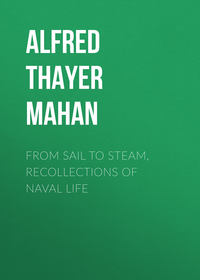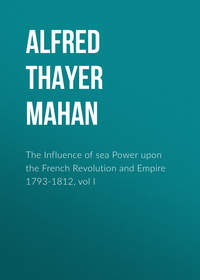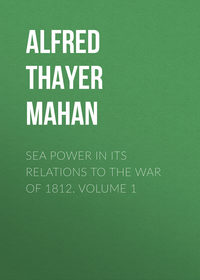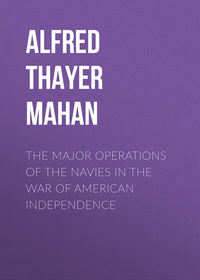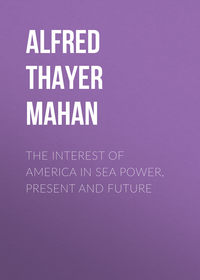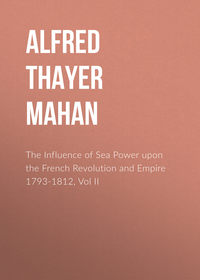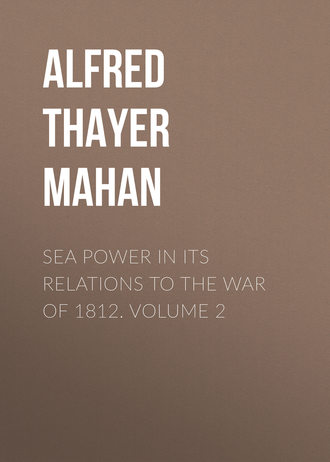 полная версия
полная версияSea Power in its Relations to the War of 1812. Volume 2
Not the least of objections was the risk to which Sackett's Harbor, the naval base, was to be exposed. After October 16, Chauncey had remained cruising between there and Kingston, covering the approaches to the St. Lawrence. His intended trip to Genesee, to bring up Scott's eight hundred regulars, had been abandoned at the urgent demand of Wilkinson, who, while the troops were being transferred from Sackett's to Grenadier Island, at the outlet of the lake to the river, "would not allow any part of the fleet to be absent four days without throwing the responsibility, in case of a failure of his expedition, wholly on the navy."114 The commodore did not learn of the new scheme until October 30, ten days after its adoption, when he was asked to cover the rear of the army from pursuit by water, by taking position inside the St. Lawrence. While objecting strongly to the change of plan, he of course consented to afford all the co-operation in his power; but he wrote to the Navy Department, "If Sir James Yeo knows the defenceless situation of Sackett's, he can take advantage of a westerly wind while I am in the river, run over and burn it; for to the best of my knowledge there are no troops left there except sick and invalids, nor are there more than three guns mounted."115
After many delays by rough water, Wilkinson's troops were assembled at Grenadier Island towards the end of October. On November 1 they began entering the river by detachments, collecting at French Creek, on the American side, fifteen miles from the lake. Being here immediately opposite one of the points considered suitable for advance on Kingston, the object of the movement remained still doubtful to the enemy. The detachments first arriving were cannonaded by four of Yeo's vessels that had come through the channel north of Long Island, which here divides the stream. On November 2 Chauncey anchored near by, preventing the recurrence of this annoyance. On the 4th the entire force was assembled, and next day started down the river with fine weather, which lasted until the 11th. Up to this date no serious difficulty was encountered; but immediately that the departure from French Creek proclaimed the real direction of the movement, de Rottenburg despatched a body of six hundred regular troops, under Lieutenant Colonel Morrison, accompanied by some gunboats under Captain Mulcaster, to harass the rear. For the purpose of being on hand to fall upon the American flotilla, should the attempt be made to cross the river to the north bank, Sir James Yeo on the 5th came out from Kingston with his fleet. He anchored on the north side of Long Island, only five miles from the American squadron, but separated by a reef, over which the "General Pike" could not pass without being lightened.116 Steps were taken to effect this, and to buoy a channel; but on the 6th Yeo retired to Kingston. Chauncey's letters make no mention of Mulcaster's division, and after Yeo's withdrawal he moved down to Carleton Island.
Morrison and Mulcaster on the 8th reached Fort Wellington, opposite Ogdensburg. Here they paused and received re-enforcements from the garrison, raising their numbers to eight hundred, who continued to follow, by water and by land, until the 11th. Then they were turned upon by the rearguard of an American division, marching on the north bank to suppress the harassment to which the flotilla otherwise was liable in its advance. An action followed, known as that of Chrystler's Farm, in which the Americans were the assailants and in much superior numbers; but they were worsted and driven back, having lost one hundred and two killed and two hundred and thirty-seven wounded, besides one hundred prisoners. The troops engaged then embarked, and passed down the Long Saut Rapids to Cornwall, which is one hundred and twenty miles from Kingston and eighty-two from Montreal. Here they were rejoined on the 12th by the vanguard of the division, which had met little resistance in its progress.
At this time and place Wilkinson received a letter from General Hampton, to whom he had written that the provisions of his army were insufficient, and requested him to send "two or three months' supply by the safest route in a direction to the proposed scene of action."117 He also instructed him to join the advance at St. Regis, opposite Cornwall, the point which had now been reached. As the two bodies were co-operating, and Wilkinson was senior, these instructions had the force of orders. In his reply, dated November 8,118 Hampton said, "The idea of meeting at St. Regis was most pleasing, until I came to the disclosure of the amount of your supplies of provision." Actually, the disclosure about the supplies preceded in the letter the appointment to meet at St. Regis, which was the last subject mentioned. "It would be impossible," Hampton continued, "for me to bring more than each man could carry on his back; and when I reflected that, in throwing myself upon your scanty means, I should be weakening you in your most vulnerable point, I did not hesitate to adopt the opinion that by throwing myself back upon my main depot [Plattsburg], where all means of transportation had gone, and falling upon the enemy's flank, and straining every effort to open a communication from Plattsburg to … the St. Lawrence, I should more effectually contribute to your success than by the junction at St. Regis."
Hampton then retired to Plattsburg, in the direction opposite from St. Regis. Wilkinson, upon receiving his letter, held a council of war and decided that "the attack on Montreal should be abandoned for the present season." The army accordingly crossed to the American side and went into winter quarters at French Mills, just within the New York boundary; on the Salmon River, which enters the St. Lawrence thirteen miles below St. Regis. Wilkinson was writing from there November 17, twelve days after he started from French Creek to capture Montreal. Thus two divisions, of eight thousand and four thousand respectively, both fell back helplessly, when within a few days of a junction which the enemy could not have prevented, even though he might successfully have opposed their joint attack upon Montreal.
It is a delicate matter to judge the discretion of a general officer in Hampton's position; but the fact remains, as to provisions, that he was in a country where, by his own statement of a month before, "we have, and can have, an unlimited supply of good beef cattle."119 A British commissary at Prescott wrote two months later, January 5, 1814, "Our supplies for sixteen hundred men are all drawn from the American side of the river. They drive droves of cattle from the interior under pretence of supplying their army at Salmon River, and so are allowed to pass the guards, and at night to cross them over to our side,"—the river being frozen. He adds, "I shall be also under the necessity of getting most of my flour from their side."120 It is not necessary greatly to respect Wilkinson in order to think that in such a region Hampton might safely have waited for his superior to join, and to decide upon the movements of the whole. He was acting conjointly, and the junior.121 Under all the circumstances there can be no reasonable doubt that his independent action was precipitate, unnecessary, contrary to orders, and therefore militarily culpable. It gave Wilkinson the excuse, probably much desired, for abruptly closing a campaign which had been ludicrously inefficient from the first, and under his leadership might well have ended in a manner even more mortifying.
Chauncey remained within the St. Lawrence until November 10, the day before the engagement at Chrystler's Farm. He was troubled with fears as to what might happen in his rear; the defenceless condition of Sackett's, and the possibility that the enemy by taking possession of Carleton Island, below him, might prevent the squadron's getting out.122 None of these things occurred, and it would seem that the British had not force to attempt them. On the 11th the squadron returned to the Harbor, where was found a letter from Armstrong, requesting conveyance to Sackett's for the brigade of Harrison's army, which Perry had brought to Niagara, and which the Secretary destined to replace the garrison gone down stream with Wilkinson. The execution of this service closed the naval operations on Ontario for the year 1813. On November 21 Chauncey wrote that he had transported Harrison with eleven hundred troops. On the night of December 2 the harbor froze over, and a few days later the commodore learned that Yeo had laid up his ships for the winter.
There remains yet to tell the close of the campaign upon the Niagara peninsula, control of which had been a leading motive in the opening operations. Its disastrous ending supplies a vivid illustration of the military truth that positions are in themselves of but little value, if the organized forces of the enemy, armies or fleets, remain unimpaired. The regular troops were all withdrawn for Wilkinson's expedition; the last to go being the garrison of Fort George, eight hundred men under Colonel Winfield Scott, which left on October 13. The command of the frontier was turned over to Brigadier General George M'Clure of the New York Militia. Scott reported that Fort George, "as a field work, might be considered as complete at that period. It was garnished with ten pieces of artillery, which number might have been increased from the spare ordnance of the opposite fort"123—Niagara. The latter, on the American side, was garrisoned by two companies of regular artillery and "such of M'Clure's brigade as had refused to cross the river."
It was immediately before Scott's departure that the British forces under General Vincent, upon receipt of news of the battle of the Thames, had retreated precipitately to Burlington Heights, burning all their stores, and abandoning the rest of the peninsula. This was on October 9; a week after de Rottenburg had started for Kingston with two regiments, leaving only ten or twelve hundred regulars. De Rottenburg sent word for these also to retire upon York, and thence to Kingston; but the lateness of the season, the condition of the roads, and the necessity in such action to abandon sick and stores, decided Vincent, in the exercise of his discretion, to hold on. This resolution was as fortunate for his side as it proved unfortunate to the Americans. M'Clure's force, as stated by himself, was then about one thousand effective militia in Fort George, and two hundred and fifty Indians. Concerning the latter he wrote, "An exhibition of two or three hundred of them will strike more terror into the British than a thousand militia."124 From time to time there were also bodies of "volunteers," who assembled on call and were subject to the orders of the national government for the period of their service. With such numbers, so constituted, it was as impossible for M'Clure to trouble Vincent as it was inexpedient for Vincent to attack Fort George.
A gleam of hope appeared for the American commander when Perry brought down the thirteen hundred of Harrison's victorious army, with the general himself. The latter, who was senior to M'Clure, lent a favorable ear to his suggestion that the two forces should be combined to attack Vincent's lines. Some four hundred additional volunteers gathered for this purpose; but, before the project could take effect, Chauncey arrived to carry Harrison's men to Sackett's, stripped of troops for Wilkinson's expedition. The urgency was real, and Chauncey pressing, on account both of Sackett's and the season. In reply to a very aggrieved remonstrance from M'Clure, Harrison expressed extreme sympathy with his disappointment and that of the volunteers, but said no material disadvantage was incurred, for he was convinced the British were removing as fast as they could from the head of the lake, and that an expedition thither would find them gone. Therewith, on November 16, he embarked and sailed.
The period of service for which the militia were "draughted" would expire December 9. To M'Clure's representations the national government, which was responsible for the general defence, replied impotently by renewing its draught on the state government for another thousand militia. But, wrote Armstrong, if you cannot raise volunteers, "what are you to expect from militia draughts, with their constitutional scruples?"—about leaving their state. Armstrong was not personally responsible for the lack of organized power in the nation; but as the representative of the Government, which by a dozen years of inefficiency and neglect had laid open this and other frontiers, the fling was unbecoming. On December 10, the garrison of Fort George was reduced to "sixty effective regulars and probably forty volunteers. The militia have recrossed the river almost to a man."125 M'Clure also learned "that the enemy were advancing in force." That night he abandoned the works, retiring to Fort Niagara, and carrying off such stores as he could; but in addition he committed the grave error of setting fire to the adjacent Canadian village of Newark, which was burned to the ground.
For this step M'Clure alleged the authority of the Secretary of War, who on October 4 had written him, "Understanding that the defence of the post committed to your charge may render it proper to destroy the town of Newark, you are directed to apprise its inhabitants of this circumstance, and to invite them to remove themselves and their effects to some place of greater safety." The general construed this to justify destruction in order to deprive the hostile troops of shelter near Fort George. "The enemy are now completely shut out from any hopes or means of wintering in the vicinity of Fort George." The exigency was insufficient to justify the measure, which was promptly disavowed by the United States Government; but the act imparted additional bitterness to the war, and was taken by the enemy as a justification and incentive to the retaliatory violence with which the campaign closed.
The civil and military government of Upper Canada at this time passed into the hands of Sir Gordon Drummond. For the moment he sent to Niagara General Riall, who took over the command from Vincent. On December 13, M'Clure reported the enemy appearing in force on the opposite shore; but, "having deprived them of shelter, they are marching up to Queenston." This alone showed the futility of burning Newark, but more decisive demonstration was to be given. Early on the 19th the British and Indians crossed the river before dawn, surprised Fort Niagara, and carried it at the point of the bayonet; meeting, indeed, but weak and disorganized resistance. At the same time a detachment of militia at Lewiston was attacked and driven in, and that village, with its neighbors, Youngstown and Manchester, were reduced to ashes, in revenge for Newark. On December 30 the British again crossed, burned Buffalo, and destroyed at Black Rock three small vessels of the Erie flotilla; two of which, the "Ariel" and "Trippe," had been in Perry's squadron on September 10, while the third, the "Little Belt," was a prize taken in that action. Two thousand militia had been officially reported assembled on the frontier on December 26, summoned after the first alarm; but, "overpowered by the numbers and discipline of the enemy," wrote their commander, "they gave way and fled on every side. Every attempt to rally them was ineffectual."126
With this may be said to have terminated the northern campaign of 1813. The British had regained full control of the Niagara peninsula, and they continued to hold Fort Niagara, in the state of New York, till peace was concluded. The only substantial gain on the whole frontier, from the extreme east to the extreme west, was the destruction of the British fleet on Lake Erie, and the consequent transfer of power in the west to the United States. This was the left flank of the American position. Had the same result been accomplished on the right flank,—as it might have been,—at Montreal, or even at Kingston, the centre and left must have fallen also. For the misdirection of effort to Niagara, the local commanders, Dearborn and Chauncey, are primarily responsible; for Armstrong yielded his own correct perceptions to the representations of the first as to the enemy's force, supported by the arguments of the naval officer favoring the diversion of effort from Kingston to Toronto. Whether Chauncey ever formally admitted to himself this fundamental mistake, which wrecked the summer's work upon Lake Ontario, does not appear; but that he had learned from experience is shown by a letter to the Secretary of the Navy,127 when the squadrons had been laid up. In this he recognized the uselessness of the heavy sailing schooners when once a cruising force of ships for war had been created, thereby condemning much of his individual management of the campaign; and he added: "If it is determined to prosecute the war offensively, and secure our conquests in Upper Canada, Kingston ought unquestionably to be the first object of attack, and that so early in the spring as to prevent the enemy from using the whole of the naval force that he is preparing."
In the three chapters which here end, the Ontario operations have been narrated consecutively and at length, without interruption by other issues,—except the immediately related Lake Erie campaign,—because upon them turned, and upon them by the dispositions of the Government this year were wrecked the fortunes of the war. The year 1813, from the opening of the spring to the closing in of winter, was for several reasons the period when conditions were most propitious to the American cause. In 1812 war was not begun until June, and then with little antecedent preparation; and it was waged halfheartedly, both governments desiring to nip hostilities. In 1814, on the other hand, when the season opened, Napoleon had fallen, and the United States no longer had an informal ally to divert the efforts of Great Britain. But in the intervening year, 1813, although the pressure upon the seaboard, the defensive frontier, was undoubtedly greater than before, and much vexation and harassment was inflicted, no serious injury was done beyond the suppression of commerce, inevitable in any event. In the north, on the lakes frontier, the offensive and the initiative continued in the hands of the United States. No substantial re-enforcements reached Canada until long after the ice broke up, and then in insufficient numbers. British naval preparations had been on an inadequate scale, receiving no proper professional supervision. The American Government, on the contrary, had had the whole winter to prepare, and the services of a very competent naval organizer. It had also the same period to get ready its land forces; while incompetent Secretaries of War and of the Navy gave place in January to capable men in both situations.
With all this in its favor, and despite certain gratifying successes, the general outcome was a complete failure, the full measure of which could be realized only when the downfall of Napoleon revealed what disaster may result from neglect to seize opportunity while it exists. The tide then ebbed, and never again flowed. For this many causes may be alleged. The imbecile ideas concerning military and naval preparation which had prevailed since the opening of the century doubtless counted for much. The intrusting of chief command to broken-down men like Dearborn and Wilkinson was enough to ruin the best conceived schemes. But, despite these very serious drawbacks, the strategic misdirection of effort was the most fatal cause of failure.
There is a simple but very fruitful remark of a Swiss military writer, that every military line may be conceived as having three parts, the middle and the two ends, or flanks. As sound principle requires that military effort should not be distributed along the whole of an enemy's position,—unless in the unusual case of overwhelming superiority,—but that distinctly superior numbers should be concentrated upon a limited portion of it, this idea of a threefold division aids materially in considering any given situation. One third, or two thirds, of an enemy's line may be assailed, but very seldom the whole; and everything may depend upon the choice made for attack. Now the British frontier, which the United States was to assail, extended from Montreal on the east to Detroit on the west. Its three parts were: Montreal and the St. Lawrence on the east, or left flank; Ontario in the middle, centring at Kingston; and Erie on the right; the strength of the British position in the last named section being at Detroit and Malden, because they commanded the straits upon, which the Indian tribes depended for access to the east. Over against the British positions named lay those of the United States. Given in the same order, these were: Lake Champlain, and the shores of Ontario and of Erie, centring respectively in the naval stations at Sackett's Harbor and Presqu' Isle.
Accepting these definitions, which are too obvious to admit of dispute, what considerations should have dictated to the United States the direction of attack; the one, or two, parts out of the three, on which effort should be concentrated? The reply, as a matter of abstract, accepted, military principle, is certain. Unless very urgent reasons to the contrary exist, strike at one end rather than at the middle, because both ends can come up to help the middle against you quicker than one end can get to help the other; and, as between the two ends, strike at the one upon which the enemy most depends for re-enforcements and supplies to maintain his strength. Sometimes this decision presents difficulties. Before Waterloo, Wellington had his own army as a centre of interest; on his right flank the sea, whence came supplies and re-enforcements from England; on his left the Prussian army, support by which was imminently necessary. On which flank would Napoleon throw the weight of his attack? Wellington reasoned, perhaps through national bias, intensified by years of official dependence upon sea support, that the blow would fall upon his right, and he strengthened it with a body of men sorely needed when the enemy came upon his left, in overwhelming numbers, seeking to separate him from the Prussians.
No such doubt was possible as to Canada in 1813. It depended wholly upon the sea, and it touched the sea at Montreal. The United States, with its combined naval and military strength, crude as the latter was, was at the beginning of 1813 quite able in material power to grapple two out of the three parts,—Montreal and Kingston. Had they been gained, Lake Erie would have fallen; as is demonstrated by the fact that the whole Erie region went down like a house of cards the moment Perry triumphed on the lake. His victory was decisive, simply because it destroyed the communications of Malden with the sea. The same result would have been achieved, with effect over a far wider region, by a similar success in the east.
CHAPTER XIII
SEABOARD MARITIME OPERATIONS
Upon the Canada frontier the conditions of 1813 had permitted the United States an ample field for offensive operations, with good prospect of success. What use was made of the opportunity has now been narrated. Upon the seaboard, continuous illustration was afforded that there the country was widely open to attack, thrown wholly on the defensive, with the exception of preying upon the enemy's commerce by numerous small cruisers. As a secondary operation of war this has always possessed value, and better use of it perhaps never was made than by the American people at this time; but it is not determinative of great issues, and the achievements of the public and private armed vessels of the United States, energetic and successful as they were at this period, constituted no exception to the universal experience. Control of the highways of the ocean by great fleets destroys an enemy's commerce, root and branch. The depredations of scattered cruisers may inflict immense vexation, and even embarrassment; but they neither kill nor mortally wound, they merely harass. Co-operating with other influences, they may induce yielding in a maritime enemy; but singly they never have done so, and probably never can. In 1814 no commerce was left to the United States; and that conditions remained somewhat better during 1813 was due to collusion of the enemy, not to national power.
The needs of the British armies in the Spanish Peninsula and in Canada, and the exigencies of the West India colonies, induced the enemy to wink at, and even to uphold, a considerable clandestine export trade from the United States. Combined with this was the hope of embarrassing the general government by the disaffection of New England, and of possibly detaching that section of the country from the Union. For these reasons, the eastern coast was not included in the commercial blockade in 1813. But no motive existed for permitting the egress of armed vessels, or the continuance of the coasting trade, by which always, now as then, much of the intercourse between different parts of the country must be maintained, and upon which in 1812 it depended almost altogether. With the approach of spring in 1813, therefore, not only was the commercial blockade extended to embrace New York and all south of it, together with the Mississippi River, but the naval constriction upon the shore line became so severe as practically to annihilate the coasting trade, considered as a means of commercial exchange. It is not possible for deep-sea cruisers wholly to suppress the movement of small vessels, skirting the beaches from headland to headland; but their operations can be so much embarrassed as to reduce their usefulness to a bare alleviation of social necessities, inadequate to any scale of interchange deserving the name of commerce.




